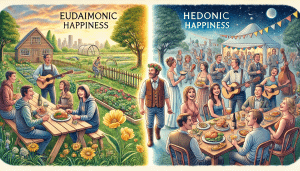
Happiness is a state that we all aspire to experience at every moment of our lives. However, happiness is not a single concept. It encompasses various dimensions, with Eudaimonic Happiness and Hedonic Happiness being two of its primary forms. These two types of happiness impact our lives in different ways, and understanding them can help us achieve a more fulfilling and complete sense of joy.
Hedonic Happiness: Momentary Joy
Hedonic Happiness is based on experiencing momentary pleasure, comfort, and joy. It is the happiness we feel in specific situations, such as:
- Enjoying a delicious meal.
- Watching a favorite movie.
- Going on a vacation or relaxing.
- Buying new clothes or gadgets.
Hedonic Happiness is rooted in sensory experiences and external stimuli, providing short-term satisfaction. While it is beautiful and essential, it is often fleeting and difficult to sustain over the long term.
The Reality of Hedonic Happiness
Hedonic Happiness is often a part of our daily lives. For example:
- The joy of scrolling through social media.
- Spending time with friends.
- Eating tasty food.
However, Hedonic Happiness often fails to fulfill our deeper needs. For instance, the happiness from buying a new gadget may fade within a few days.
The Hedonic Treadmill
One of the main challenges of Hedonic Happiness is the concept of the “Hedonic Treadmill.” This refers to the tendency of humans to quickly adapt to new sources of happiness and return to their baseline level of satisfaction. For example, the excitement of buying a new car may wear off within weeks, leading us to seek the next source of pleasure.
Eudaimonic Happiness: Deep and Lasting Fulfillment
Eudaimonic Happiness is a deeper, more enduring form of happiness rooted in purpose, meaning, and personal growth. It is achieved through:
- Discovering the meaning of your life.
- Pursuing goals aligned with your values.
- Developing your skills and abilities.
- Helping others and contributing to society.
The Reality of Eudaimonic Happiness
Eudaimonic Happiness is about a profound understanding of life. Examples include:
- Helping others through your work.
- Living authentically according to your beliefs and values.
- Achieving challenging goals.
- Contributing to solving family or societal problems.
For instance, the satisfaction a mother feels when making difficult decisions to support her family, or the joy a teacher experiences by improving their students’ lives, are examples of Eudaimonic Happiness.
The Science Behind Eudaimonic Happiness
Psychological studies show that Eudaimonic Happiness has long-term benefits for both the mind and body. For example:
- Mental Health: It reduces depression and stress.
- Physical Health: It boosts the immune system.
- Long-Term Fulfillment: It connects us to a sense of purpose and meaning in life.
Balancing Hedonic and Eudaimonic Happiness
Hedonic Happiness and Eudaimonic Happiness are not opposites. They are two paths that can coexist. Hedonic Happiness brings momentary joy, while Eudaimonic Happiness provides long-term fulfillment and meaning.
Strategies for Achieving Balance
- Seek Momentary Joy: Enjoy delicious food, entertainment, and relaxation.
- Find Long-Term Meaning: Discover the purpose and goals of your life.
- Contribute to Society: Help others and engage in acts of kindness.
- Focus on Personal Growth: Learn new skills and develop your abilities.
The Journey to Happiness
Happiness is a journey. It includes both momentary pleasures and deep, lasting fulfillment. Hedonic Happiness helps you enjoy the present, while Eudaimonic Happiness adds long-term satisfaction and meaning to your life.
Strive to find both types of happiness in your life. Seek opportunities for momentary joy while also exploring the deeper meaning and purpose of your existence. This balance will enrich and complete your life.
Happiness is a journey, and it lies within you. Start seeking it today!
What type of happiness do you experience in your life? Hedonic or Eudaimonic? Share your thoughts with us!
Discover more from Pasindu Lakshan Perera
Subscribe to get the latest posts sent to your email.




